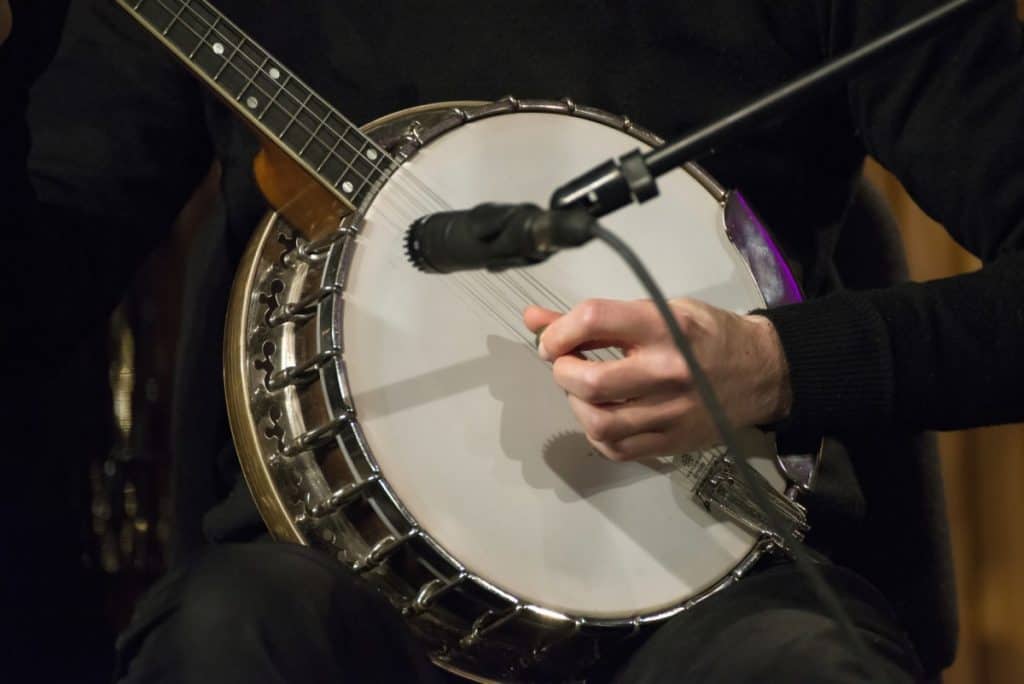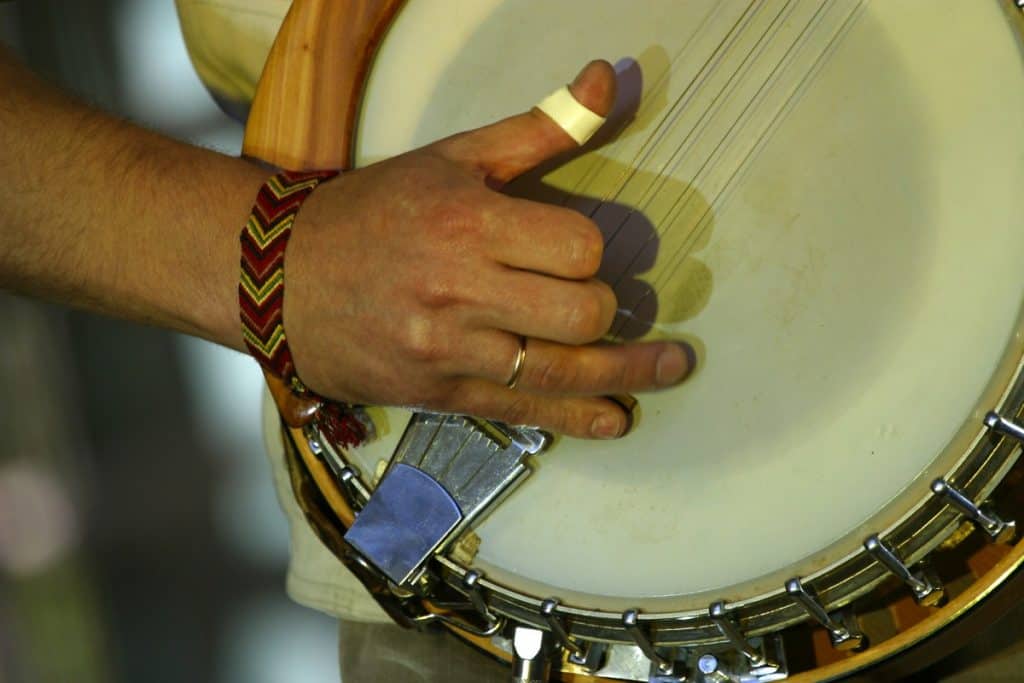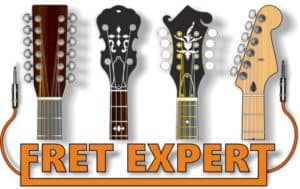Want to know how easy it is to play the banjo? First, it’s worth mentioning that using traditional picking techniques requires a steeper learning curve than the guitar or ukulele, for example. That’s not to infer that it’s one small step towards impossible either – it just needs a little more application.
More than most other fretted instruments, the banjo is very reliant on very specific picking techniques to make the instrument really come to life.
I’ll discuss the varying methods used by the majority of today’s leading players and from there you should be able to point yourself in the right direction with regard to online lessons, video masterclasses, etc.
Covered in this Article:
5 Reasons You Might Find the Banjo Easy to Learn
1. Experience with Another Fretted Instrument
If you already play an instrument to a reasonable standard, your learning curve will be considerably shallower for the banjo than it is for the total beginner.
Obviously, this is more applicable to a fretted or bowed instrument player than to a wind player, keyboard player or percussionist. Saying that, anybody who has acquired a degree of finger dexterity may well find the learning process is a little easier than a fellow learner without a musical background.
2. Patience and Stickability
The key to learning any new skill is as much down to your own persistence and determination as to any innate natural ability you may already possess.
Nothing beats practice and although I’d like to offer you instant solutions and shortcuts, the reality is new skills need to be honed over time. If you’re impatient and want quick wins, you might be better off learning the ukulele, since most people can pick up some chords in a day.

3. Learning on Good Quality Instrument
This one seems self-evident, but you’d be surprised at how many people will struggle on with a badly set-up instrument with poor intonation, terrible action (the height of the strings above the fretboard) and awful tonal qualities.
Obviously, you may be hampered by financial constraints, but when you can, it’s always better to buy a decent playable banjo, rather than a bargain-basement instrument that would be more suitable for a dumpster than a music setting.
Some instruments just need a bit of a set up by an experienced hand (instrument technician, banjo teacher, music store, friend, etc.), while others are beyond salvageable due to a badly warped neck and incorrectly spaced frets. The latter can be corrected, but it’s not a cheap twenty-minute job.
Where you can, it’s always best to buy from your local music store and preferably from a store that specializes in banjos or fretted instruments in general. I do realize that’s not always practical, so thankfully there are some fine online sellers who include a proper set-up as standard.
You may pay a little more because of this, but the likelihood is you’ll have a much better instrument to begin your banjo journey.
4. The Desire to Play the Banjo
Nothing really beats the beginner who possesses a natural affiliation towards the banjo or any other instrument for that matter. The adage, one volunteer is worth ten pressed men couldn’t hold more true.
If you really want to do something, the likelihood is you’ll pursue it with a lot more enthusiasm, than someone who is railroaded into it. This is a common reason why so many children give up music beyond the school setting.
If you’re deciding between the banjo and another instrument, ask yourself which one you’re most passionate about.

5. Availability of Good Resource Material
I can’t stress too much how fortunate the newbie musician is these days compared with the limited resources that were available when I was growing up. We take YouTube and other online services for granted, but in historic terms, this type of learning is very much still in its infancy.
If you live in some remote location, it’s highly probable that a banjo teacher might not be available. This is where the likes of online tutoring via Zoom or recorded lessons via YouTube really are an invaluable resource. Printed material is also more widely available, beyond a basic Mel Bay introductory method book.
If you do take online one-to-one lessons via webcam, I would advise you to find a teacher who’s happy for you to record the lessons on your computer or device. This will allow you to go back and review the information at your leisure, as well as to make full use of the pause and rewind/fast forward features.
The other advantage with online lessons is you aren’t time zone reliant and can usually find a slot that will suit both you and your teacher, wherever you are in the world.
I would also avoid teachers who commit you to an expensive course of lessons, before you’re sure whether the banjo is the instrument for you. Ideally, you should be able to pay as you go or at the very most, monthly, without a greater commitment.
5 Reasons You Might Find the Banjo Hard to Learn
1. Trying to Run Before You Can Walk
Nothing is as self-defeating as trying to emulate your favorite players before you have sufficient technique to do so. Trying to be Earl Scruggs or Béla Fleck after two months practice is a surefire recipe for disappointment and abandonment of the banjo.
Slow and steady is a much used phrase, but it applies to almost anything you’re learning. Copying a complicated picking pattern will take a lot of practice, which should be done at a much reduced tempo and a bar or two at a time.
Even the most accomplished musicians don’t just sit down and tear through a new piece without getting the fundamentals of it down accurately, before they appear to do it effortlessly.
It can be useful to use a metronome (either manual or electronic) to stop yourself from getting too carried away in this respect. Set it at a low tempo and maintain that tempo until you’re confident to move it up a step or two. You can even use certain software to reduce the speed of an existing recording to a more manageable tempo.
It also helps to play with fellow musicians who are patient enough to slow down for you or to join in with learners who are at similar point on their musical journeys. It’s not a sprint, it’s a marathon!
2. Developing bad habits
Although I’m certainly not an advocate of super rigid learning methods, if a certain way works for you, it’s still sensible to take careful note of how other people have achieved their successful techniques and methods.
You can often adapt a particular technique or tweak it a little to suit your own playing style. No two musicians will play in an identical way and what suits one may be anathema to another.
3. Using the Wrong Fingers
Although it’s not a deal breaker, using the correct fingers with both your fretting and picking fingers will make everything fall into place a little more naturally than trying to wing it in the early stages of learning.
A lot of players have very specific idiosyncrasies attached to their player style, so if you find a particular method that works better for you, don’t feel constrained to copy an existing ‘norm’!
4. Learning On a Sub-Standard Instrument
In one sense, I’m just reiterating the point I covered in the ‘Easy’ play section. But I do feel the idea needs driving home, if you’re to realize your full potential and to maintain interest in the banjo. Thankfully, there are a lot of quite playable instruments available today, which will serve you well in the early stages of your musical development.

5. Underlying Health Issues
In an ideal world, there would be no bar to learning anything you wished to pursue. Sadly some people do have significant health issues which may affect their ability to play the banjo or any other instrument. Some of the problems can be obviated to a certain extent by accepting your limitations and altering how you approach the instrument.
Mainstream and alternative medical solutions may well allow someone with arthritis, carpal tunnel syndrome, finger sensitivity, etc. to still pursue the music they love. So before you’ve explored all the possible solutions for your particular condition, I wouldn’t throw in the towel just yet!
A couple of high profile cases in point are Black Sabbath’s guitarist, Tony Iommi who lost part of a finger in an industrial accident and Rick Allen of Def Leppard who still plays the drums with his remaining arm and a little electronic ingenuity, following an automobile accident. In many cases where there’s a will, there’s a way!
I have a separate article on ‘11 Ways to Stop Your Fingers Hurting When Playing the Ukulele‘. Many of the points are applicable to playing the banjo or any other fretted instrument, if you suffer from finger pain.
Bonus Point on Making Banjo Playing Quieter
With the banjo being a naturally loud instrument, this can somewhat curtail practice if you have thin adjoining walls and banjo-hating neighbors! See my article on ‘How to Mute Your Banjo to Practice Quietly – Step by Step‘.
In conclusion, the difficulty you may encounter during your banjo escapades will very much be related to how dedicated you choose to be!
Regular daily practice will always trump one two-hour session once every two weeks! You can go it alone, but if at all possible take advantage of a teacher or experienced banjo-playing friend.
Nothing beats passed down knowledge, when you get stuck in a rut or feel you aren’t really understanding a particular aspect of playing technique. Good luck!
